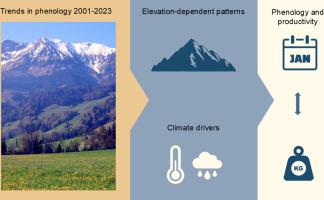在变暖的世界中,欧洲山区植物物候和生产力的分化趋势
IF 5.7
1区 农林科学
Q1 AGRONOMY
引用次数: 0
摘要
全球变暖正在影响陆地生态系统的物候和生产力,对碳循环产生重大影响。然而,在气候异质性山区,植物物候趋势是如何变化的,以及这些趋势如何影响生态系统生产力仍不清楚。利用中分辨率卫星数据(500 m),我们分析了2001 - 2023年欧洲主要山脉植被类型和海拔之间物候趋势和生产力的差异。在阔叶林中,季末的变化超过了季初的变化(+0.15对-0.05 d-⁻¹),而在天然草原中则相反(+0.03对-0.23 d-⁻¹)。这些变化的幅度随着海拔高度的变化而显著变化:草地春季物候在高海拔地区比低海拔地区发展得更快,而阔叶林春季物候表现出山脉特有的海拔响应——阿尔卑斯山和喀尔巴阡山脉的春季物候在低海拔地区比高海拔地区发展得更快,而比利牛斯山脉和斯堪的纳维亚山脉则没有。阔叶林的秋季物候在高海拔地区比低海拔地区表现出更大的延迟,这可能是春季和夏季干旱造成的。以23年时间序列的z分数计算的气候异常,很好地预测了物候异常(最大R²= 0.51),尽管23年的气候趋势与物候变量的相关性很弱(最大R²= 0.27),这表明植物对长期气候变化的适应不同于对短期气候变化的适应。生长季长(GSL)与生产力呈显著相关(最大R2 = 0.60),特别是在“限冷”植被中。然而,GSL与生产力的时间趋势不相关(R²< 0.03)。在过去的23年中,只有22%的森林像元和16%的草地像元的GSL显著增加,而20%的森林像元和53%的草地像元的生产力显著增加。我们的研究结果表明,GSL以外的因素会影响生态系统的生产力,这表明生长季节的延长并不一定会转化为欧洲山区生产力的提高。本文章由计算机程序翻译,如有差异,请以英文原文为准。

Diverging trends in plant phenology and productivity across European mountains in a warming world
Global warming is affecting phenology and productivity of terrestrial ecosystems, with large implications for carbon cycling. However, how plant phenological trends are shifting in climatically heterogenous mountains, and how these trends affect ecosystem productivity remains unclear. Using moderate resolution satellite data (500 m), we analyzed differences in phenological trends and productivity between vegetation types and along elevation in Europe’s major mountain ranges between 2001 and 2023.
End-of-season shifts outpaced start-of-season changes in broadleaved forests (+0.15 vs. -0.05 d y⁻¹), while patterns in natural grasslands were opposite (+0.03 vs. -0.23 d y⁻¹). The magnitude of these shifts varied significantly with elevation: grassland spring phenology consistently advanced more at high than at low elevations, while broadleaved forest spring phenology exhibited mountain range-specific elevation responses—advancing more at low than at high elevations in the Alps and in the Carpathians, but not in the Pyrenees and in the Scandinavian Mountains. Autumn phenology of broadleaved forests showed greater delays at high than at low elevations, likely due to spring and summer droughts. Climate anomalies, calculated as Z-scores across the 23-year time-series, predicted phenological anomalies well (max R² = 0.51), although trends in climate over 23 years and phenological variables were related only weakly (max R² = 0.27), suggesting that plants adjusted to long-term differently than to short-term climate change.
Growing season length (GSL) was strongly coupled with productivity (max R2 = 0.60), especially in “cold-limited” vegetation. Nonetheless, temporal trends in GSL and productivity were not related (R² < 0.03). In the last 23 years, GSL significantly increased in only 22 % of forest and 16 % of grassland pixels, but productivity in 20 % of forest and 53 % of grassland pixels. Our results suggested that factors beyond GSL affect ecosystem productivity, indicating that longer growing seasons will not necessarily translate into increasing productivity across European mountains.
求助全文
通过发布文献求助,成功后即可免费获取论文全文。
去求助
来源期刊
CiteScore
10.30
自引率
9.70%
发文量
415
审稿时长
69 days
期刊介绍:
Agricultural and Forest Meteorology is an international journal for the publication of original articles and reviews on the inter-relationship between meteorology, agriculture, forestry, and natural ecosystems. Emphasis is on basic and applied scientific research relevant to practical problems in the field of plant and soil sciences, ecology and biogeochemistry as affected by weather as well as climate variability and change. Theoretical models should be tested against experimental data. Articles must appeal to an international audience. Special issues devoted to single topics are also published.
Typical topics include canopy micrometeorology (e.g. canopy radiation transfer, turbulence near the ground, evapotranspiration, energy balance, fluxes of trace gases), micrometeorological instrumentation (e.g., sensors for trace gases, flux measurement instruments, radiation measurement techniques), aerobiology (e.g. the dispersion of pollen, spores, insects and pesticides), biometeorology (e.g. the effect of weather and climate on plant distribution, crop yield, water-use efficiency, and plant phenology), forest-fire/weather interactions, and feedbacks from vegetation to weather and the climate system.

 求助内容:
求助内容: 应助结果提醒方式:
应助结果提醒方式:


